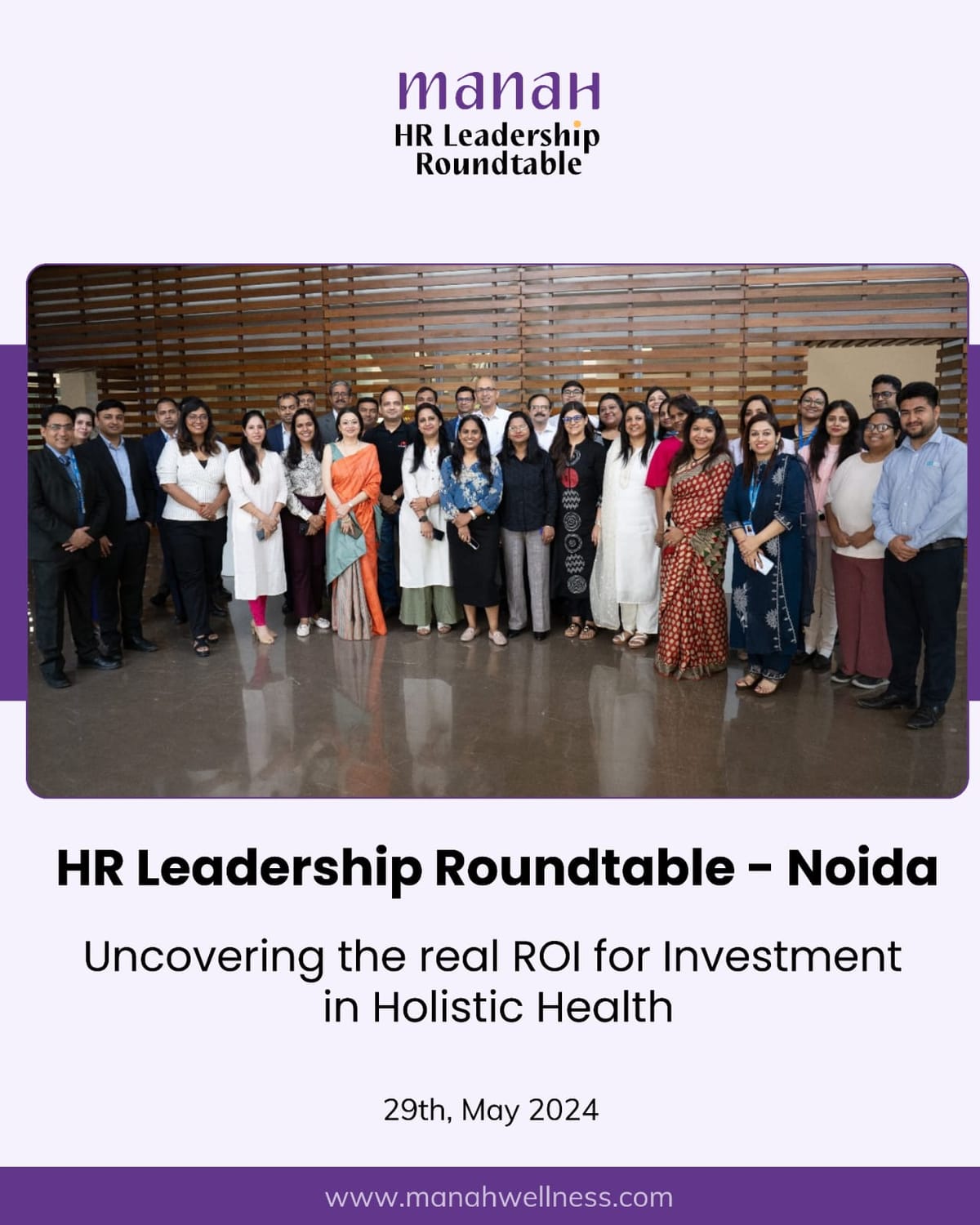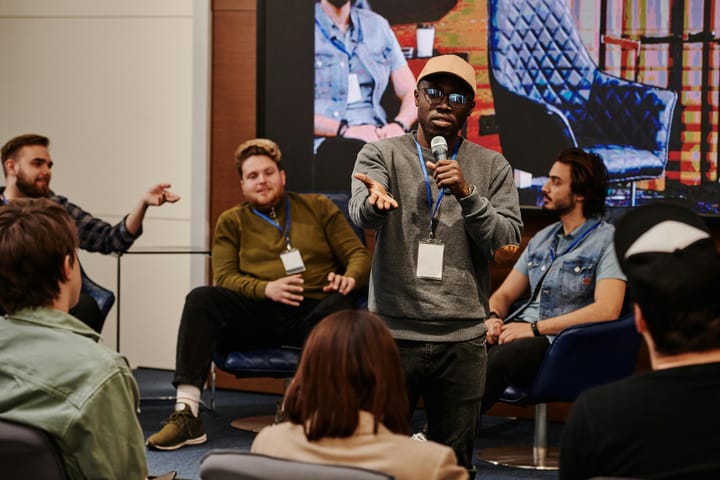Energizing the Workforce with Empathetic Leadership

Manah Wellness, in collaboration with HCL Healthcare, hosted an HR Roundtable Discussion in Noida on 29th May 2024. The high turnout and the subsequent success of the event were a testament to the fact that the HR community wants to connect, to help each other move from viewing employees as just another unit of the organization to humans and social beings with unique needs.
The heartwarming discussion revolved around understanding what wellbeing means to different individuals, making the workplace more empathetic, and tailoring workplace wellbeing programs to help them feel comfortable accessing them in times of need. Senior HR leaders from different parts of the country took part in the discussion and made it clear that it was time for all organizations to go from transactional to a more humanistic leadership style.
Let’s get a glimpse of the major themes discussed during the roundtable discussion.
What does wellbeing mean to you?
Debasmita Sinha, Clinical Director of Manah Wellness remarked, “Wellbeing is a skill. Self-love is discipline.”
Wellbeing means different things to different people, especially in an environment where different generations of employees work together in tough situations. The post-COVID era has changed a lot about how we perceive work and life. Unless employees are at ease, we can’t expect them to be dedicated or contribute meaningfully.
The HR leaders unanimously agreed that stepping up as an organization to equip yourself to support your employees’ wellbeing is the best way to keep your in-house talent happy, energized, and engaged. One of the best ways to ensure employees take wellbeing initiatives seriously is by extending (physical and mental) health programs to employees and their families.
Every employee sees wellbeing differently. But, overall, wellbeing is a discipline, not an image of indulgence. It takes commitment to work on oneself and commitment on behalf of the organization to allow room for the employees to work on themselves.
The value of feeling seen in an organization
The Roundtable discussion deliberated on a major chunk of wellbeing – feeling seen in the workplace – not merely as an employee, but as a holistic individual. An employee needs to have a balance between work, personal life, and opportunities to grow in both arenas.
Vivek Pathak, Group Head - HR & Admin at Planetcast Media Services Limited observed, “Wellbeing is feeling seen by the organization.”
When employees are seen for the good work they do, interacted with regularly, asked to be supported in their journey, and given breathing room to be who they are instead of putting on a perfect image, and still being valued, they develop a sense of wellbeing, that slowly permeates into all aspects of their lives.
They begin to imbibe confidence to take care of their wellbeing, get help where they need and start working on themselves. That’s exactly what psychological safety does to an individual, and an organization at large.
Strengthening boundaries between work and life
One of the most important points that came up during the discussion with the HR Leaders is that regardless of whether people commute home every day, or reside within the company’s campus, they come to work leaving family behind. But, mentally, they carry family and emotional issues into work and ruminate over what’s happening in their lives.
A trusted confidante at work – someone who is trustworthy, non-judgemental, a patient listener, and who is genuinely interested in your wellbeing – can make you feel cared for in your organization. That’s what a dedicated counselor or mental health provider does.
When it comes to the manufacturing business, work, and life are often blurred. This is especially true for manufacturing plants that offer residence to workers inside the campus. With the same machine noise, environment, people, and lifestyle over and over again, the likelihood of them being lonely, and carrying the emotion to work is pretty high. If they had issues in the family, they’d be occupied with constant worrying, and feeling helpless since they’re away from home.
Vinita Ankur, Head Of Human Resources at ShipsKart cited, “Empathetic leadership and extending health benefits to families drive retention post-COVID.”
When this happens, it becomes difficult for them to concentrate, unable to stick to work hours, progress slows down, and they isolate themselves from others. A lack of support especially at a time when things are going down a spiral for an employee, further brings the employees down. Deepti Mehta says this is where Chief Happiness Officers come into the picture in their organization.
Do we have protocols for mental health emergencies?
There are laws, and strict protocols in place for organizations to adopt when anyone faces physical danger or a safety hazard. The law details every step of the hazard’s aftermath, right from whom to report to, what first aid to administer, etc.
One of the leaders in the event raised an important question – what happens when an employee has a panic attack in the middle of the workday? What happens if an employee has a psychosomatic incident, and is helpless? What happens if an employee has a sudden meltdown?
No one would have an action plan for such an emergency. Who do you inform? What protocol to follow and when? What emotional first-aid should you administer to give interim relief to the person in distress? When these incidents happen, do you simply send them to a quiet room to deal with it, or simply give them a 5-minute break to calm down, or ask them to carry on with their day? Is your organization equipped with the knowledge and understanding of such situations and the appropriate steps to take during these times?
These are questions not many organizations can answer because they consider only physical hazards as threats to wellbeing. This is where the whole conversation about creating a healthy workplace starts.
Make mental health programs effortlessly accessible
For employees to know exactly where to get help in light of the above-mentioned situations, they need to be constantly reminded of the fact that they have the right resources at their disposal, and can be accessed without any hassle, waiting time, or an iota of doubt of confidentiality. This is a crucial thread the HR leaders discussed at length, at the Roundtable event.
This happens when organizations tailor wellbeing programs to suit the employees’ schedule, at a time when the employees’ minds aren’t bogged down with deadlines, meetings, and calls. Usually, when you organize initiatives for mental health, you check for employees’ schedules, and shift timings, consult with a bunch of managers, and come up with a timing that suits everyone.
But, what if wellbeing was one major work aspect that is factored into when planning work for the month, quarter, or year? What if we went from treating wellbeing initiatives as a part of a once-in-a-blue-moon engagement initiative to treating it as an everyday essential the employees can’t go without?
Sushil Sharma, Senior Vice President of Human Resources at 1Lattice stated, “Be humanistic leaders. Ensure employees feel safe to participate in wellness initiatives.”
The latter approach shows you’re sincerely hoping for the employees to best use programs, your adoption rate skyrockets, and you’re able to see solid ROI in terms of improved productivity, better bonding within teams, healthier relationships, improved communication patterns, increased trust and an organization culture that puts employees first.
The HR leaders who participated in the roundtable empathized with others and realized there was a whole community of like-minded people who shared the same concerns they had in mind. It was a seed for a warm HR community, to open up and help each other.
Manah Wellness is planning more such roundtable discussions in the future in different cities. Stay tuned for more updates!



